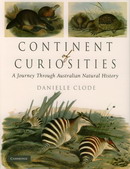review by Lynne McCarthy

'... a journey through the back rooms of a museum — through a natural history collection — inspired by a handful of the strange and curious creatures collected there ... These stories take us into our historical past, our evolutionary past and our geological past and beyond, to the future'. (p. 12)
In Continent of Curiosities: A Journey through Australian Natural History, Danielle Clode presents 11 specimens from Museum Victoria collections where '... each of these individual objects exists within a rich and vibrant tapestry of knowledge and understanding about the world we live in' (p. 4). These objects are used to uncover links to broader themes that contribute to our understanding of the natural world, including the European discovery of Australia, Indigenous knowledge, taxonomy, evolution, geological theories, principles of biogeography, conservation, wild life ecology, and exploration and discovery.
This book is organised around four parts, moving back in time from hundreds, to billions of years before the present. Each part is accompanied by a timeline that succinctly orders key ideas and themes encountered in each chapter. In Chapter 1 (Part 1, 'Visions from the Old World: The last 500 years'), Clode sets the scene for the book by drawing on childhood memories of the natural history museum: 'row upon row, cabinet after cabinet of rocks, shells, stuffed and pickled animals, strange bones, enormous eggs and bizarre agglutinations' (p. 4). Clode continues that, many years later, her fascination shifts to the work of the scientists and extensive collections behind the display halls. It is here we are introduced to the central premise of this book — 'a closer insight into the hidden nature of museums' (p. 4), — enquiry and research into objects that, 'in the hands of their curators, the mundane, the rare and the dazzling, all become keys to other worlds' (p. 9). Inspired by an eclectic range of objects from Museum Victoria collections, each chapter reveals and challenges our thinking and interpretation of the natural world. Chapter 2 explores the 'discovery' of the kangaroo from perspectives of European imagination and Indigenous knowledge. This theme is extended in Chapter 3 with a discussion of the nature and relationship of a long and productive history between scientific and Indigenous knowledge.
Part 2, 'Into the forests: The last 250,000 years', begins with a discussion about water as a resource, and provides historical and geographical perspectives on maintaining Melbourne's water quality and health of water catchment areas. Clode then moves to intriguing descriptions of the biodiversity and ecology of mountain ash forest communities in Chapter 5. Here we are introduced to the role of fire and disturbance in forest ecosystems. The mystery of reappearing possums in Chapter 6 provides the reader with insights into a broader discussion of impacts of European settlement on wildlife and ecosystems, habitat modification, competition from introduced species, and extinction.
Clode begins Part 3, 'From fossils and bones: The last 250 million years', by exploring scientific discussions around the significance of Trigonia in Chapter 7, 'The case of the missing mollusc', and how the study of fossils more broadly influence and change interpretations of the natural world. Clode brings this mystery into the present day in her discussion of the ongoing interest in these shells with respect to the science of classification and taxonomy. Chapter 8 illuminates the world and role of fossils from collections and what they can tell us about species of the past. The reader then encounters nineteenth-century debates about theories of evolution and creationism and Australian arguments over human evolution in Chapter 9.
Part 4, 'Visions of new worlds: The last 4.5 billion years' continues the discussion of evolution, and musings on the origin and distribution of species. We meet Alfred Wallace in Chapter 10 and his work on the distribution patterns of bird species across Asia and Australia. Interestingly, Clode extends this discussion by situating Wallace's work within the happenings of nineteenth-century colonial exploration. Her discussion covers other scientists working at the time, and the dynamic and heated scientific debate and discussion that contributed to founding principles of biogeography. Chapter 11 continues the investigation into geological theories that underpin key developments in the biological sciences, in particular, the history of Wegner's theory of continental drift. The final chapter of the book explores claims and research into potential life forms on Mars — a planet regarded as the most 'earth'-like in our solar system. Clode presents fascinating information about the history and research on the discovery of bacterial life forms on Martian meteorites.
Clode's engaging writing style throughout the book would appeal to both the natural science enthusiast and a more general audience. Dispersed throughout each of the chapters are intriguing case studies that further enrich and spark interest and enquiry into natural history and, at the same time, provide wonderful glimpses into the work of museum curators and scientists in their quest to build knowledge of museum collections. The inclusion of plates and illustrations of collection objects and the various subjects and themes explored in each chapter, also contributed to my overall enjoyment of this book. Clode concludes with a list of sources that provide further information for readers interested in the science of natural history collections, the changing roles and history of museums, and the contributions of explorers towards the understanding of Australian zoology.
Clode brings to the fore the agency of natural history objects in museum collections. The objects are part of a larger narrative that link 'things' with discovery, research and inviting new ways of seeing, interpreting, and understanding how the natural world operates. This book provides a truly delightful and engaging journey into the intrigue, and depth of knowledge gleaned from a selection of curious objects.
Lynne McCarthy is currently a research fellow in the Centre for Historical Research at the National Museum of Australia.
